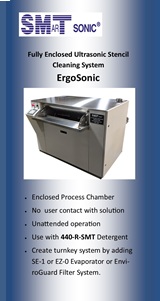|

|
|
| Ask the Experts | |||||||
|
|||||||
|
October 30, 2024 - Updated October 25, 2023 - Originally Posted Trays for MLS BakingIs it acceptable to use glass trays for MSL integrated circuit baking? Is there a particular material recommended for MLS baking trays? R.N. |
|||||||
| Expert Panel Responses | |||||||
|
If using glass use laboratory grade Pyrex.
President JSK Associates Based in. Northern California since 1971. Founded JSK Associates in 1979. Actively involved in soldering, cleaning, chemistries. 30 years experience in EOS/ESD control.
What material to use for baking trays will depend on the temperature you use to do the bake. For sure, you should use a tray that can withstand the baking temperature and with an ESD dissipative surface/coating. Components placed on an insulator (like glass) could be subjected to ESD events that could damage them.
Senior Project Engineer Electronic Controls Design Inc Paul been with Electronic Controls Design Inc. (ECD) in Milwaukie, Oregon for over 39 years as a Senior Project Engineer. He has seen and worked with the electronic manufacturing industry from many points of view, including: technician, engineer, manufacture, and customer. His focus has been the design and application of measurement tools used to improve manufacturing thermal processes and well as moisture sensitive component storage solutions.
Glass is an insulator and given the right conditions the glass surface can hold an electrical charge. Glass is not a good material for use in baking out sensitive electrical components because the glass insulator can hold an ESD charge and thus it can be discharged into your components during bake out. A better material is a conductive plastic material that has black carbon particles added to it so that it is designed for ESD dissipation which slowly conduct static charges away – this material is called static dissipative and can be procured from Vendors that manufacture PCB fixtures and pallets for running thru your reflow process or across the selective solder wave / standard solder wave processes. These materials are rated to handle the temperatures needed for bake out as well as the ESD requirements.
VP Engineering Services STI Electronics Inc. Mark T. McMeen is STI Electronics Inc.ʼs Vice President of Engineering Services. He oversees the daily operations of the Engineering Services division of STI. He has over 18 years experience in the manufacturing and engineering of PCBs.
Most companies use Durostone CAS761 or very similar materials for trays, fixtures, and tooling intended for hot processing of ESD components and assemblies, such as for convection reflow, oven baking to cure adhesives or to dry PWBs, vapor phase reflow, and for cleaning and baking after washing. Just Google up "Durostone CAS761" and you will see dozens of suppliers of the material itself, as well as many companies that fabricate fixtures, trays, tools, etc. to your specifications. Durostone CAS761 is a dissipative material, and it withstands heat and chemicals extremely well. It is available in sheets down to about 10 mils thick all the way up to giant blocks, pretty much anything you need. Be sure to spell it with two O's and no A's. Glass is a really bad choice as it can be tribo-charged to greater than 10Kv just by rubbing it on any insulator. It is also easily breakable and does not have any place in an electronics manufacturing china shop with lots of bulls walking around. There are also other materials very similar to Durostone CAS761. Some are not as easy to machine, others are better for some processes and not so good for others. But a good start is to just Google up Durostone CAS761 and discuss your needs with the suppliers. They can direct you to other similar materials that may be better for your particular application, as well as provide you with information on companies that are particularly good at making the tools or fixtures you need.
Advanced Engineer/Scientist General Dynamics Richard D. Stadem is an advanced engineer/scientist for General Dynamics and is also a consulting engineer for other companies. He has 38 years of engineering experience having worked for Honeywell, ADC, Pemstar (now Benchmark), Analog Technologies, and General Dynamics.
|
|||||||
| Submit A Comment | |||||||
|
Comments are reviewed prior to posting. You must include your full name to have your comments posted. We will not post your email address. |
|
Free Newsletter Subscription
Circuitnet is built for professionals who bear the responsibility of looking ahead, imagining the future, and preparing for it. Insert Your Email Address |
|

|





